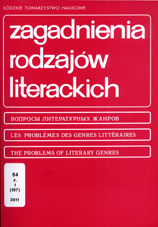
Materials to “The Companion of the Literary Genres”
Materiały do "Słownika rodzajów literackich"
Etiuda Hortulus Powieść egzystencjalistyczna Powieść naturalistyczna
More...
Etiuda Hortulus Powieść egzystencjalistyczna Powieść naturalistyczna
More...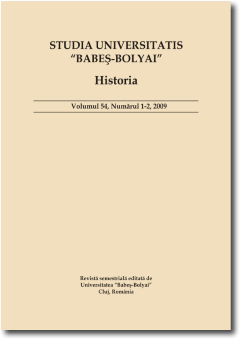
Keywords: mendicant orders; ecclesiastical topography; spiritual influence; Observance; religious iconography.
This paper offers a critical overview of results of late or current researches about the male friaries of the Mendicant Orders in Transylvania during the Middle Ages (13th – 16th c.) from five angles that have been recently explored mainly by French, Italian, German and English medievalists: 1) the geography and topography of the Mendicant friaries of Transylvania, 2) the material running and economy of these friaries, 3) their influence on society and lay piety, 4) the impact of the Observance-trend, 5) the use and signification of images. Finally, it raises the issue of the hypothetical “Transylvanian exception”.
More...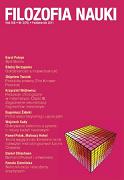
Keywords: scientific discovery; Max Planck
The historical development of scientific knowledge is examined in the context of research, and not, as tradition tells, in the context of justification. It is a story about experimental researches and theoretical investigations conducted in the years 1820- 1902, which finally led to the discovery of electron, accompanied by methodological comments. Main results of the analysis are that knowledge is scientific if it has a systemic character, and experimental studies are scientific if they are systematic. „Systemic” means that studied objects or processes are assumed (a) to obey to the same laws, (b) if we know nothing about that the change of experimental situation can influence the given theoretical property of an object or process, than this property, determined in other successful applications of an accepted theory (i.e. the set of laws), should be attributed to objects or processes in new applications of the same theory. „Systematic” means that the same objects or processes are examined experimentally in a number of different, but interrelated, situations (so many as time, money and available laboratory instruments allow). I also try to show that in the historical growth of scientific knowledge hypotheses, understood as „free creations of the imagination”, do not play almost any role. Almost all theoretical discoveries are products of inferences that can be logically reconstructed and whose premises are (1) known and accepted laws of nature, (2) what is known about the studied objects on the basis of approved applications of these laws, (3) new experimental results. The moral of this is that theoretical discoveries appear if and only if the system of scientific knowledge is mature enough: it is impossible to draw conclusions, if you lack the necessary premises. A scientist cannot, by letting her imagination to run wild, to be ahead of her time, and if she tries to do that, she usually goes beyond the boundaries of science.
More...
Keywords: Leibniz; history of informatics
Leibniz may be considered as the first computer scientist. He made major contributions to engineering and information science. He invented the binary system, fundamental for virtually all modern computer architectures. He built a decimal based machine that executed all four arithmetical operations and outlined a binary computer. The concepts of lingua characteristica (formal language, programming language) and calculus ratiocinator (formal inference engine or computer program) are the base of the modern logic and information science. Leibniz was groping towards hardware and software concepts worked out much later by Charles Babbage and Ada Lovelace. He anticipated the universal Turing machine.
More...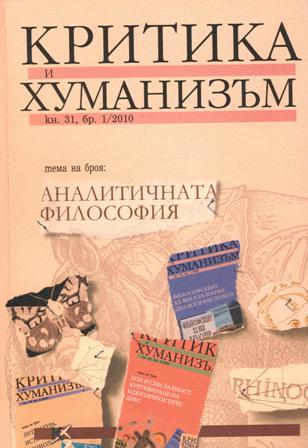
Keywords: logic; analytic philosophy; Russell; philosophical logic; relations
The failure to distinguish method from subject-matter is in the basis of many of the problems that arise when Russell tries to think logical form relationally, and the absence of suffi cient control over the idealizations of the science of logic annihilates the thrust of his revolutionary turn to ‘logical data’ – an annihilation without which he could be not a mere predecessor but a direct participant in the so-called praxeological turn in logic. The article considers how this ensues from his conception of philosophical logic, how the relationist philosophical logical analysis is carried out and to what paradoxes it can lead. An idea is proposed as to what levels of idealization can become visible with such an optic on Russell.
More...
Keywords: Dakien; Lager; Soldatenkaiserzeit; spezifische Vorgänge; Vergleich; obergermanisch-raetischer Limes; Verringerung der Bestände.
The Forts of Dacia during the Time of the Soldier Emperors. I. Aspects of the Internal Architecture I discuss in this paper some issues and situations that appeared or seem to have appeared in the internal architecture of the Dacian castra at the time of the „military anarchy”. I followed mostly the significance of these situations for estimating the number of soldiers who were stationed there. Comparisons with more or less similar situations from the forts of the Germano-Raetic frontier have been made, especially with those from Germania Superior.
More...Am 9. Mai 1957 brachte der Kurator der evangelischen Kirchengemeinde in Hermannstadt, Hermann Müller, im Rahmen der abendlichen Presbyterialsitzung einen Antrag von bemerkenswertem Ehrgeiz vor. Das spätgotische Wandbild an der nördlichen Chorwand der evangelischen Stadtpfarrkirche in Hermannstadt, das sogenannte Rosenauersche Kreuzigungsgemälde (Abb. 1), befinde sich in schlechtem Zustand und sei in „barocker Malart willkürlich abgeändert“ worden. Es seien deshalb einige Schritte nötig, um das Gemälde wieder in sein Recht zu setzen: Erstens solle es gereinigt und in diesem Zuge „auf eventuelle Schäden und […] schlecht übermalte Stellen“ untersucht werden.
More...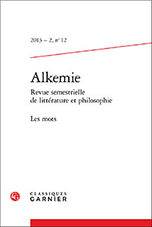
Keywords: origin of languages; word-tool; Descartes; Condillac; Leibniz.
Words are tools which depend on social, spatio-temporal, and linguistic environments, have a history, and produce psychological, political, and paradigmatic effects. The stakes implicit in their conservation and classification are high and, despite modernday technology and the primacy of the image, they remain, as Descartes would have it, the mark of humanity.
More...Keywords: Lotze; Husserl; Intentionality; Perception; Experience
Lotze’s influence on the development of the XIXth and XXth century philosophy and psychology remains largely neglected still today. In this paper, I examine some Lotzean elements in Husserl’s early conception of intentionality, and more specifically in his rejection of the Brentanian concept of intentionality. I argue that Husserl and Lotze, pace Brentano, share a qualitative conception of experiences, what they both call the Zumutesein of experiences. Furthermore, I discuss other issues upon which Husserl and Lotze share common intuitions: the perception of space, the theory of local signs, the realisations of thinking (Leistungen des Denkens) and phenomenology.
More...Keywords: Nicolae Petrescu-Comnen; diplomat; First World War; Geneva
Nicolae Petrescu-Comnen served the interests of the Romanian people in crucial moments: in Geneva, Switzerland, during World War One; at the Peace Conference in Paris; in his country's Parliament between 1920 and 1923; as Romania's plenipotentiary for Switzerland and permanent delegate to the League of Nations from 1923 till 1927.Between 1927 and 1937 Petrescu-Comnen was, in turn, plenipotentiary in Berlin, then the Vatican and back to Berlin. He was appointed undersecretary of state at the Romanian Ministry of Foreign Affairs in 1937 and then became head of this department for the next two years. From 1938 to 1941 Comnen was the Romanian ambassador to the Holy Chair. In 1943, he performed successful negotiations on both belligerent sides in view of sparing the invaluable artistic treasures hosted by Florence. As a result, it was decided that this sanctuary should not be turned into a battlefield, and Nicolae Petrescu-Comnen was awarded the distinction of "honorary citizen" of the beautiful Italian city. Finally, he founded the Romanian Red Cross Committee in exile in 1943, and presided this organization until 1952.
More...
Keywords: Adygea, Krasnodar Reservoir (Kuban Sea);Plateau Lago-Naki;Scythian gold;agro industry;tourism;heritage;development;cooperation;Circassians in Kosovo;cultural cooperation
In this paper is considered the Republic of Adygea, one of the smallest federal subjects of the huge and complexly organized Russian Federation. Here is presented a concise history of building of the republic, as its today’s natural characteristics: geographic position, area size and population, relief, climate and water, and natural resources and economy. Especially is emphasized the attractiveness of its touristic destinations and cultural heritage, as conditions for tourism development. Specific possibilities for cultural cooperation between Serbia and Adygea provides Circassian minority, who settled in Kosovo (and in other parts of Serbia) after the Crimean War, one part of which returned to the homeland.
More...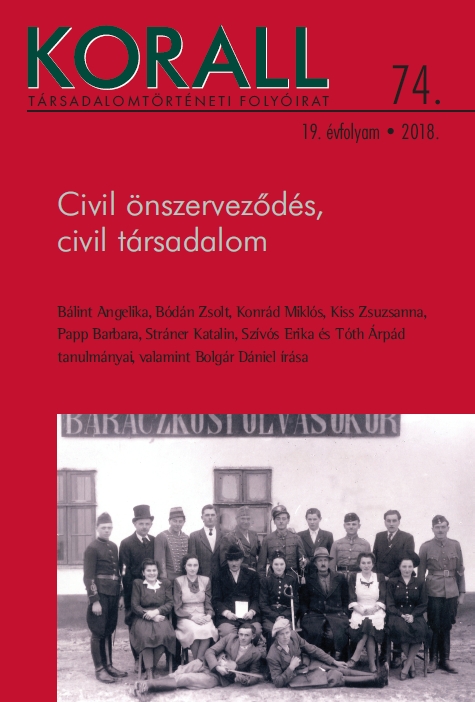
Keywords: hungary;social history;jewish society;physical education;
Between the birth of the anti-Semitic political movement and the Holocaust, the discourse about Jews mostly concentrated on their successes. The disad- vantages of Jews in physical competitions or in games associated with the body received less attention. The present study examines what produced the impres- sion of the overall failure of Jewish students in high school physical education: did their actual substandard performance cause Jewish students’ grades to be lower or did their teachers underrate their performance under the influence of the myth of inferior Jewish physique? The comparative analysis of the so-called physical strength charts used at the turn of the century sheds light on the differ- ences between physical education grades of Jewish and non-Jewish students. The figures confirm that Jewish students compared to their non-Jewish peers were in fact better athletes than how they were perceived by their teachers: their low grades were a result of biased assessment.
More...Keywords: History of Philosophy; Interwar Romanian Philosophy; Benedict Spinoza; Ethics; the Idea of God; Correspondence; Index;
Iosif Brucăr (1888-1960), born in Bukovina, was a philosopher and historian of philosophy, concerned with metaphysics, knowledge theory, philosophical historiography, logic and phenomenology. He dealt, especially, with Benedict Spinoza and his philosophy. In 1930, in order to mark 250 years from Spinoza's death, Iosif Brucăr published his most famous work, The Philosophy of Spinoza. His interest in Spinoza was the constant of his life. He worked so hard to finish another important volume about his favorite philosopher, but only the plan of this projected volume survived, as it was sent to a very good friend of Brucăr, professor Theodor Lavi Löwenstein, from Hebrew University of Jerusalem. This material refers to their correspondence and also to the plan of Ethica Repetita. The plan comes from the File RM 349 of The Central Archives for the History of the Jewish People in Jerusalem.
More...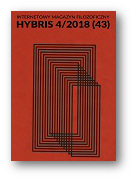
Keywords: Metaphysics; metaphysica generalis; metaphysica specialis; philosophy;
Raščlanjavanje metafizike na metaphysica generalis i metaphysica specialis, dalja podela metaphysica-e specialis na cosmologia, psychologia i theologia rationalis (naturalis) u školskoj metafizici 18. veka ima načelno značenje za dva dominanta oblika mišljenja, i određuje upravo oblikovanost tog mišljenja. Kantova „Transcendentalna dijalektika” u Kritici čistog uma je izgrađena po šemi metaphysica-e specialis. Ona se može razumeti kao destrukcija nasleđene metafizike na niti vodilji njenih osobitih predmeta. Pa ipak se tada postavlja zadatak da se ta destrukcija metafizike u transcendentalnoj dijalektici misli zajedno sa izgradnjom jedne metafizike u transcendentalnoj analitici. Jer, prema vlastitim Kantovim rečima ne bi smelo da bude nikakve sumnje u to da se u jedinstvu transcendentalne analitike i transcendentalne dijalektike, dakle, u transcendentalnoj logici, radi o jednoj metafizici. [...]
More...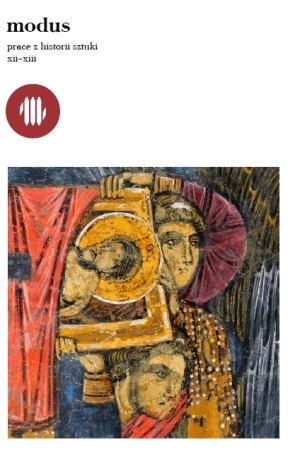
Keywords: architecture;palace and parc groups;
The paper deals with the history of a pałace located in Prokocim, a district of Cracow, morę precisely, with the first stage of its construction, in Classicist style, which was carried out at the times when the property had been owned by the Wodzicki family. The (incomplete) archival materials of the Wodzicki family, held in the Ossoliński Institute in Wrocław, enabled a reconstruction of the history of the complex in the eighteenth and at the beginning of the nineteenth centuries. The following stylistic and comparative analyses, possible thanks to the two printed views showing the palace before its subsequent Neo-Baroque remodelling in the 1870S that were discovered in the research, have revealed that the palace belongs to a group of the so-called palaces with a rotunda in the corner, thus named by Tadeusz S. Jaroszewski who ascribed them to Chrystian Piotr Aigner. Regrettably, the preserved archival and iconographic materials did not unequivocally specify the period when exactly the complex had been built in the Classicist forms, and since no plans or designs have been preserved, there are no grounds for speculation as to the original idea of the palace, its possible architect or builders. The first part of the article, based on archival materials, outlines the different stages of construction of the palace complex and its gardens. Next, thanks to the above-mentioned iconographic sources, the appearance of the palace at the turn of the nineteenth century has been reconstructed. Further, the author analyses the relationships between the Prokocim complex and a group of palaces with a rotunda in the corner located on Polish lands and, based on examples in European architecture, suggests a possible derivation of this architectural pattern.
More...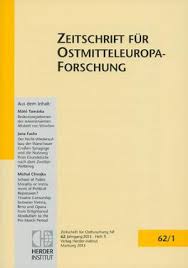
Keywords: Poland; Second Republic; minorities; Ukraine; nationalities; eastern policy; prometheism; nationhood;
The relationship with Ukraine and the Ukrainians played a role in all phases of planning and creating modern Polish statehood, in particular with regard to the territorial dimension of the new state to be created in the East. The ‘Ukrainian question’ was also raised in terms of the Ukrainian population, as part of the minority problem of the Second Polish Republic. Last but not least, relations with Russia, an existential problem from a Polish perspective, were also affected, contributing to their exposed position in both internal and external politics. The political camps in Poland addressed the ‘Ukrainian question’ with very different degrees of intensity and, especially, continuity. The issue was much more of a priority for the national democrats than for the conservatives and agrarians—the approach was far from consistent. Only the socialists (even before the First World War) had thoroughly dedicated themselves to the national question in general, and the Ukrainian problem in particular. For them, it was clear that Polish independence and the establishment of a sovereign state were closely linked to resolving the ‘Ukrainian question’. This was the only productive way to improve Poland’s international position, and, above all, her relationship with Russia. The debates on the Ukraine problem were conducted in relatively small elite circles, marginalized in the legislature and hardly affected political practice. Inspired by the catchwords ‘autonomy’ and ‘self-government’, extraordinary trains of thought emerged, which had genuine potential to resolve urgent issues of nationality politics, even beyond Poland’s borders. Despite the profound discursive deliberations about all the problems associated with the ‘Ukrainian question’, and, especially after 1926, the actually available political resources to realize the proposed solutions, a state concept for implementing them never really emerged. The model of social or even state coexistence always remained unfocused and, ultimately, the political will to implement it was lacking.
More...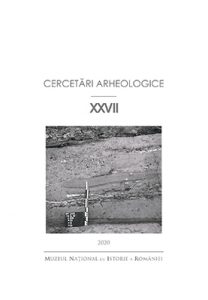
Keywords: Andrieșescu; radio; art; Dacia; Odobescu;
We are presenting here the unpublished texts of some conferences delivered by the Romanian archaeologist Ioan Andrieșescu (1888-1944) on the National Radio. One of the most important archaeologists of the inter-war era, a well-known professor of archaeology and prehistory, Andrieșescu joined a handful of other professionals in delivering a series of conferences on a wide range of subjects related to the history of archaeology, personalities of archaeology, prehistoric art and current archaeological research in Romania.
More...